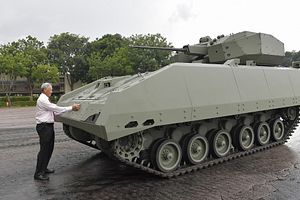This week, Singapore officially commissioned its new armored fighting vehicle. The commissioning, which occurred as scheduled amid an anniversary parade, spotlighted one aspect of the country’s wider ongoing efforts to modernize its military capabilities.
Singapore, one of the more capable militaries in the Asia-Pacific, has continued to modernize its military in recent years, with the goal of equipping the Singapore Armed Forces (SAF) with new assets and technologies to become a next generation force. Officials including Defense Minister Ng Eng Hen have articulated the various components inherent in this multiyear effort, including increased hybridization and digitization.
One of the ongoing efforts within Singapore’s military modernization has been the gradual replacement of the aging Ultra M113 Armored Fighting Vehicles (AFV), which had been in service since the 1970s. As part of this effort, which dates back to the 2000s, a new vehicle, dubbed the Hunter AFV, was designed to replace the Ultra M113 AFVs and had been under development by the Defense Science and Technology Agency (DSTA) along with Singapore Technologies Engineering and the Singapore Army, with the project officially announced in March 2017.
This week, the Hunter AFV was in the headlines with its official commissioning, in line with the previous 2019 estimate that had been unveiled earlier. On June 11, as part of the Armor Formation’s 50th anniversary parade at Sungei Gedong Camp, Defense Minister Ng commissioned the Hunter AFV as the Singapore Army’s newest addition to its armored forces. The parade was also attended by other officials including Singapore’s Chief of Defense Force Melvyn Ong, Chief of Army Major-General Goh Si Hou, and other senior officials from the Ministry of Defense and the Singapore Armed Forces (SAF).
In his remarks at the parade, Ng framed the commissioning of the Hunter AFV as a key part of the Singapore Army’s transformation into the Next-Generation Army, a stronger, faster, smarter, and more lethal advanced fighting force. He also said the Hunter AFVs represented “a significant step-up in all areas” including in terms of firepower, mobility, protection, and potency.
The Hunter AFV does indeed represent a significant boost relative to the Ultra 113 AFVs. Per Singapore’s defense ministry (MINDEF), the Hunter AFVs offer increased speed and operating range, enhanced lethality, enhanced C4 and network capabilities, and enhanced survivability and mobility. As the Singapore Army’s first fully digitized AFV, it is equipped with features such as a remote-controlled weapon station, integrated combat cockpit, automatic target detection and tracking system, all-round surveillance system, laser warning system, a drive-by-wire capability, and a range of weapons systems. It can also be integrated with other unmanned platforms as well.
While the Hunter AFV has now been officially commissioned, Ng said it would be expected to made its debut appearance at Singapore’s National Day Parade later this year, offering a glimpse of it to Singaporeans. He also indicated that it would be featured in exercises and training engagements that Singapore holds overseas through a range of existing partnerships, remarking that he expected the Hunter AFV to make “overseas hunting expeditions to Australia and other training grounds.”

































